Observation | 5 pictures depicting the Web3 stack in 2019
Author: Kyle Samani, Multicoin Capital Managing Partner
Original title: "Web3 Stack, 2019 Edition"
Source: multicoin.capital
A year ago, I described the Web3 stack I understood at the time.
- Satoshi Shinmoto 丨 Why was Satoshi Nakamoto born on April 5, 1975?
- Swedish central bank partners with Accenture to launch e-krona e-krona pilot platform
- Yi Huanhuan, Dean of Beijing Mutual Gold Association Research Institute: "Blockchain + Finance" will come to fruition in 2020, and the blockchain will enter a new era of smart contracts
Since then, I have learned a lot and the ecosystem is constantly evolving, so I decided to update my introduction to the Web3 stack.
The 2018 edition only visualized a single instance of the Web3 stack, while the 2019 edition aims to present the Web3 stack as a set of interoperable networks. To achieve this, I divided the 2019 edition into 4 pictures (plus an additional picture), starting from a narrow perspective and then expanding from there.
These pictures are large and not easy to read on the Multicoin website or in your email inbox. Although we also list the pictures in this article, you may need to open them in a dedicated image viewer after downloading for better understanding. For ease of reference, these pictures are labeled v2.1, v2.2, v2.3, v2.4, and v2.1bonus, respectively.
This article will go like this: I will first make some observations and comments on observable topics throughout the ecosystem. We will then explain how these observations are reflected in our portfolio structure. Finally, I will summarize these 4 + 1 pictures.
Observation # 1: Heterogeneity, fragmentation, and uncertainty
The most significant difference between the 2018 and 2019 versions is that the 2018 version does not well demonstrate the heterogeneity of the Web3 stack. When I published the 2018 version of the article in July 2018, no smart contract chain was running except Ethereum. Today, around Ethereum, EOS, Tezos, and Cosmos, a series of ecosystems are constantly growing, and at the same time, around the upcoming blockchains such as Kadena, Polkadot, Near, Solana, Dfinity, Tari, and Coda, have also been established Up a smaller community. Obviously, as I wrote earlier in this year 's spin-off of Ethereum, the Web3 ecosystem is growing more diverse.
A year ago, developers didn't have to think about which chain to build on, because there was only one option. Nowadays, a large number of options bring great complexity to the teams that build protocols and services on the existing chain, as well as new teams entering the cryptocurrency field. Let's look at an example:
Aragon is one of the early protocols built on Ethereum. A few weeks ago, the Aragon team announced that they would extend their protocol based on the Cosmos SDK, while continuing to support the Aragon protocol on Ethereum. They stated that the main motivation for switching blockchains is high and variable fees (I have pointed out in "Ethereum's spin-off" that fees will be one of the main driving forces forcing the team to leave Ethereum).
Terra powers more than $ 1 million in e-commerce in South Korea every day, and its adoption is growing rapidly. The Terra team chose to build on the Cosmos SDK because they needed a fast and cheap payment method.
Looking at the Web3 ecosystem, I find that the rate of fragmentation is accelerating. Although most developers prioritize Ethereum, many teams have requirements that Ethereum cannot currently support. This creates a lot of opportunities for protocol developers on other chains, and challenging blockchains are stepping up to support application developers.
Uncertainty over Ethereum 1.0 and 2.0 exacerbates this split. For example, Ethereum core developers recently (indefinitely?) Delayed the state lease on the 1.0 chain. While this is a good thing for existing contracts, it may not be ideal for the Ethereum ecosystem in the long run, as it will leave more open issues for a longer period of time . At the same time, it is clear that the Ethereum 2.0 specification is far from being finalized; Ethereum 2.0's shard count has recently been reduced from 1024 to 64.
Developers don't want to worry about introducing disruptive changes to the underlying protocol all day.
If any blockchain can take the lead in providing all of the following services, it will definitely win tangible opportunities:
- High throughput, low latency, low fees, full decentralization of consensus layer, clear scalability solution
- Robust execution environment and development tools
- Application / Sharding / Minimum Layer 2 Complexity
- Strong guarantee for backward compatibility and future stability
Developers don't want to worry about introducing disruptive changes to the underlying protocol all day. They want a solid foundation and build on it.
Observation # 2: The Rise of Middleware
In the 2018 article, I highlighted the middleware stack on the right side of the stack. In the 2019 version, I have instead divided the middleware between on-chain protocols and off-chain services.
Over the past year, middleware has seen explosive growth, most notably in the form of open finance (also known as DeFi) in the Ethereum ecosystem. Although there is a value capture problem for some types of open financial protocols (such as Set ), there are clear value capture mechanisms for other types of open financial protocols (such as Compound and Maker ).
As far as I know, none of the on-chain middleware protocols have been ported to other chains. However, some off-chain services are being ported across chains. Loom runs across Ethereum, EOS, and Tron, and even allows users to transmit DAI across all three chains. Considering the uncertainty of Ethereum 2.0, the rise of the Cosmos ecosystem and the development of some new ecosystems, I expect that in the next 12 months, we will see the accelerated development of cross-chain services. For example, services like Keep 's tBTC will naturally be used to port BTC to many chains such as Ethereum and Binance Chain.
Some services will be ported across chains and will still provide roughly the same functionality. For example, Keep's tBTC can provide basically consistent services regardless of the chain it is ported to. At the same time, off- chain services, such as dFuse and The Graph , have developed better because they can support more chains. As these services add support for specific use-case chains, such as Arweave (one-time payment and permanent IPFS-based file storage) and Handshake (decentralized DNS), these services are increasingly acting as a single abstraction layer for developers Regardless of where the underlying data is located. Therefore, the proliferation of these types of off-chain services will accelerate the development of the entire ecosystem.
Another common theme for off-chain services is that they often use a utility token model . This reflects a consensus among developers that application-specific payment currencies that do not sink in speed will not capture value, while utility tokens provide a quantifiable way to evaluate the value of off-chain services.
In addition to providing customized off-chain services, the Cosmos and Polkadot ecosystems also embrace the utility token model. In the Cosmos ecosystem, each zone will use its native pledged tokens for security protection, and the validator may receive most of the transaction fees for more liquid payment tokens such as tBTC and stablecoins income. Since most Cosmos regions do not have native mobile payment currencies, each region is expected to use Cosmos's Inter-Blockchain Communication (IBC) protocol to port tBTC and stablecoins to each region for payment and smart contracts. In addition, as a native token of the Cosmos Hub (Hub), ATOM is a utility token that will incur fees by passing messages between multiple regions. Polkadot's DOT is similar to ATOM: they perform the same function-passing information between Parachains in exchange for fees.
Finally, it needs to be explained that I believe that middleware protocols and services can obtain value from the layer 1 smart contract platform in an independent and modular way. Because the value of middleware protocols can be evaluated using traditional discounted cash flow (DCF) models, no matter which underlying chain wins, middleware protocols and services should be able to capture value. However, most universal Tier 1s are ultimately competing for non-sovereign currency , and Tier 1 value capture will be independent of middleware tier value capture.
Web3 stack 2019: single chain, flat visualization
The first image is an updated version of the Web3 stack that I demonstrated last year:
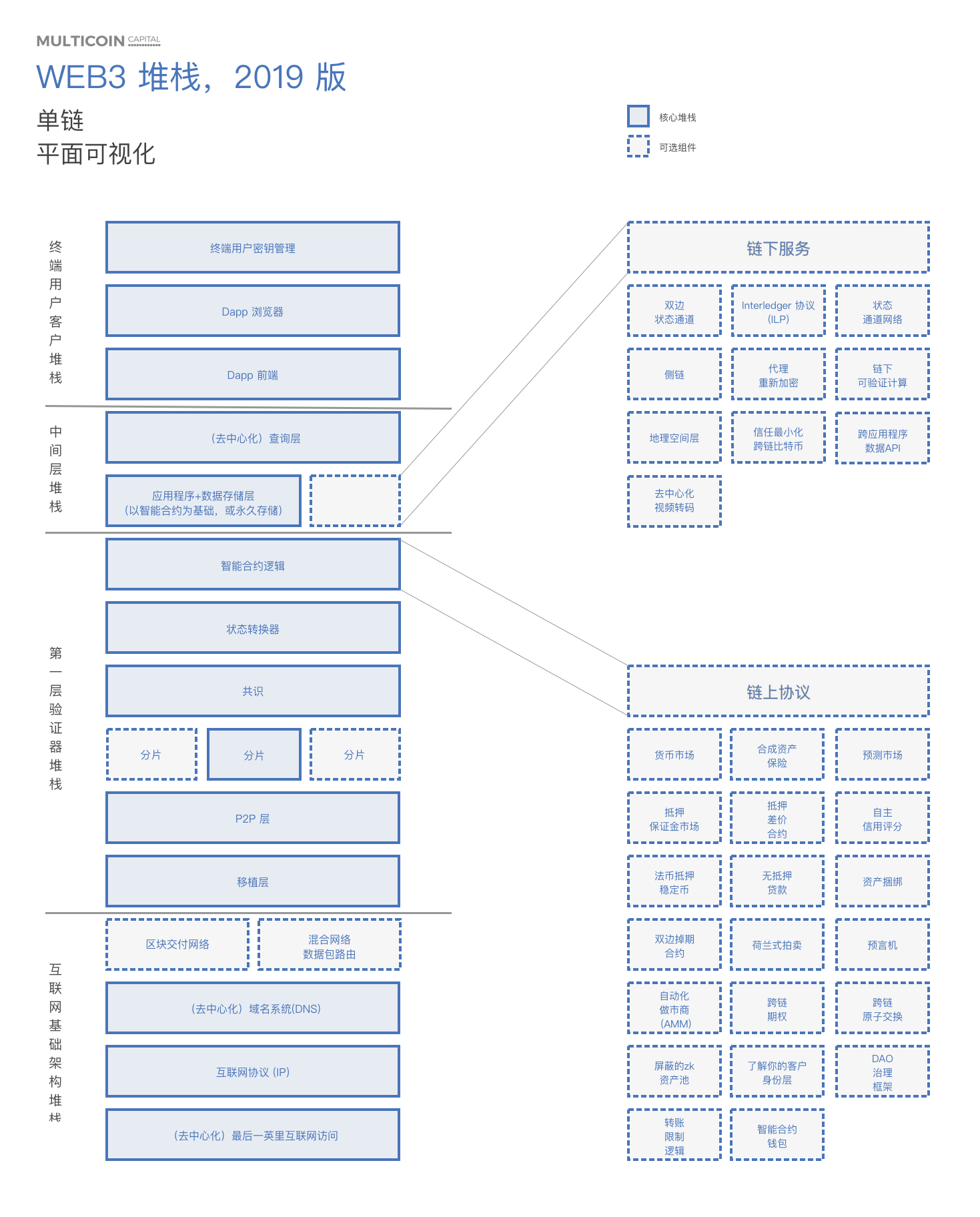
The most important changes are:
- Classify on-chain protocols and off-chain services. The ultimate vision is to abstract all the Web3-enabled mechanical infrastructure so that developers can focus on higher-level issues. Therefore, with the modular function of smart contracts on the chain, more and more applications are built based on other protocols on a single chain. This is evident in Ethereum's open financial ecosystem. Modularity and composability are the defining characteristics of open finance. Most of the on-chain protocols shown in the figure are related to open finance.
- The Web3 stack runs on many different physical computers, which are organized into different logical networks. The 2018 version shows the entire stack as if it was running on a piece of hardware. The 2019 version uses the left-hand block to distinguish each layer of the stack. This makes it easier for everyone to track and view interactions between different physical machines.
- I removed some optional components from the core stack, the sidechain, the Interledger Protocol (ILP), and the status channel, and instead listed them as optional components on the right. This makes the entire image easier to read and makes the logical representation of the stack network more consistent, which is also reflected in the next image.
I built this diagram to include some companies in the Web3 ecosystem.
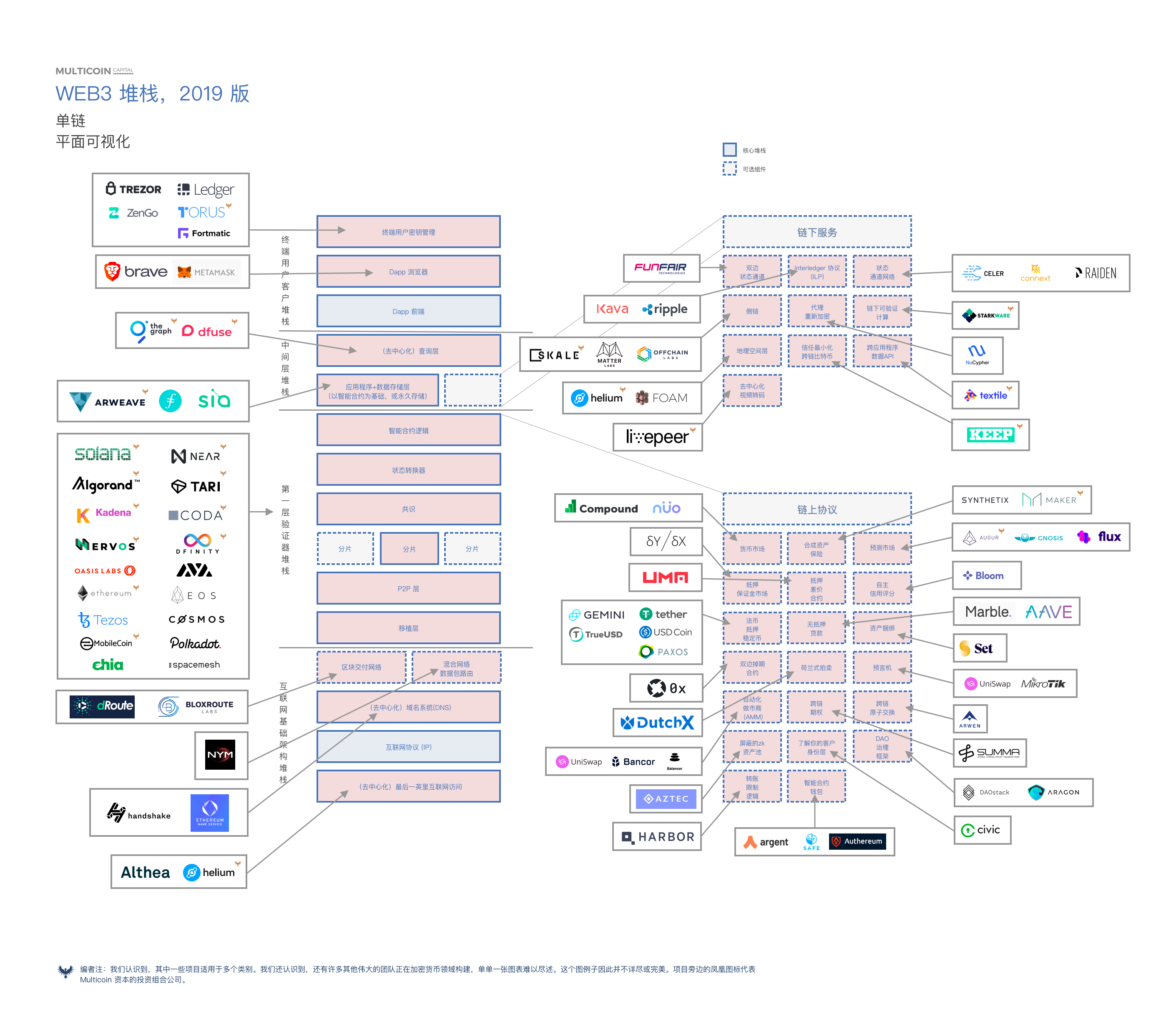
Web3 stack 2019: single chain, hierarchical visualization
The second image of the 2019 edition basically shows the same content as the first. However, the first method describes the stack flatly, but the second method shows the stack as a physical computer network. Compared to the first diagram, this visualization makes things clearer, where each substack starts and stops, the layering of substacks on different logical networks, and the flow of API calls across the network.
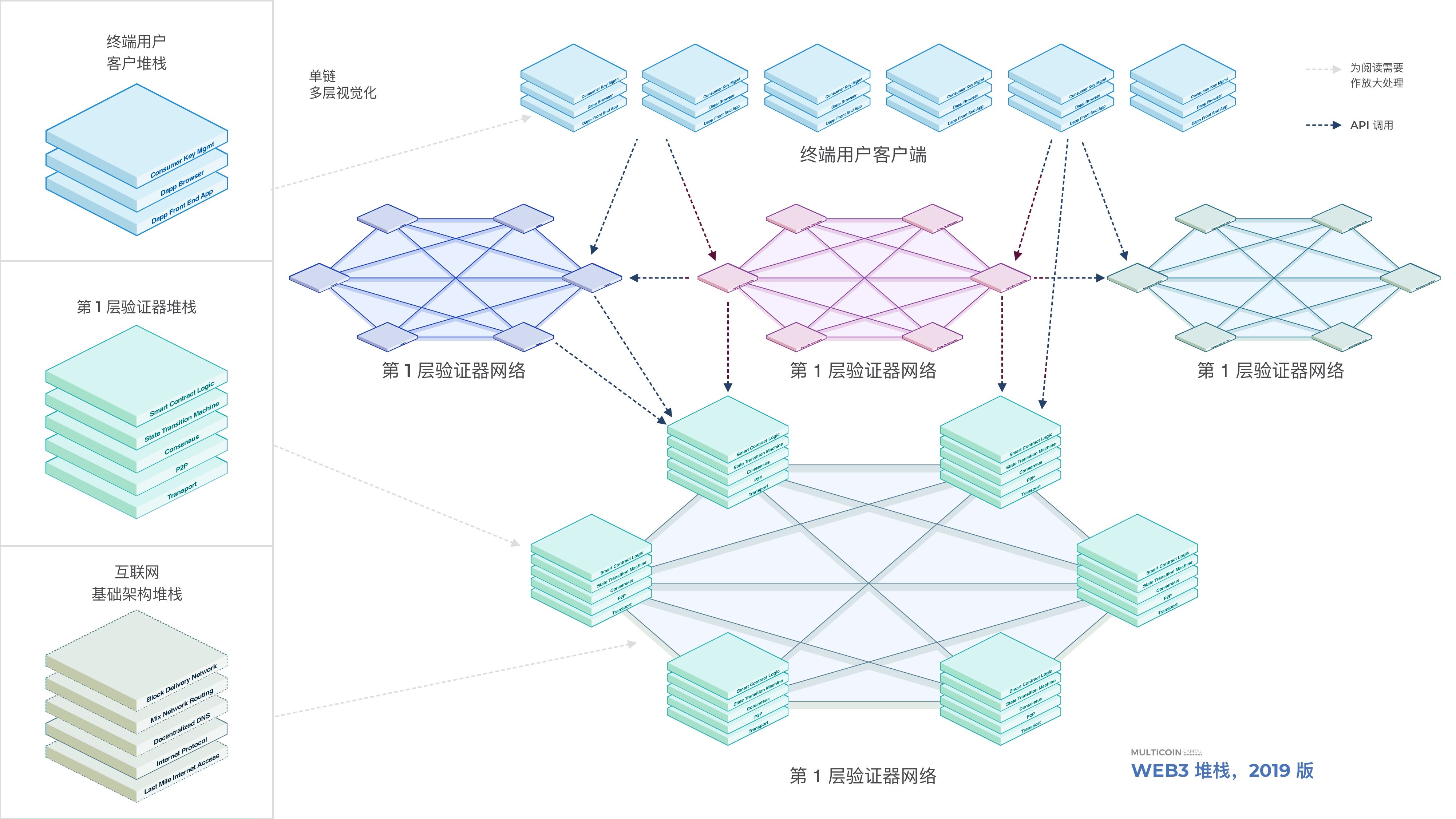
In this diagram, I show three examples of middleware networks: a query layer network (such as The Graph ), a sidechain network (such as Skale ), and a permanent storage network (such as Arweave) , which can also be used as any Data availability layer of the network). Depending on the particular application, many other middleware networks may be involved. I emphasize these three because I think they are the most widely used networks. That's why we invested in these three companies.
There are some interesting findings: First, the layers are not strictly sequential. For example, the query layer can index data from sidechains and storage networks. Second, end-user clients do not have to rely strictly on the middleware network. They can query data directly from the layer 1 network (although this often results in a poor user experience, so we expect the query layer to be more robust and widely adopted, which will be less common). Third, an independent data availability network can serve as the data availability layer for layer 1 (this cannot be visualized).
Web3 Stack 2019: Multi-chain, flat visualization
As I mentioned above, the Web3 ecosystem is becoming more heterogeneous, rather than homogeneous. As more Tier 1 rolls out, this is a natural phenomenon. This diagram attempts to illustrate what the ecosystem will look like when more chains begin to connect to each other:
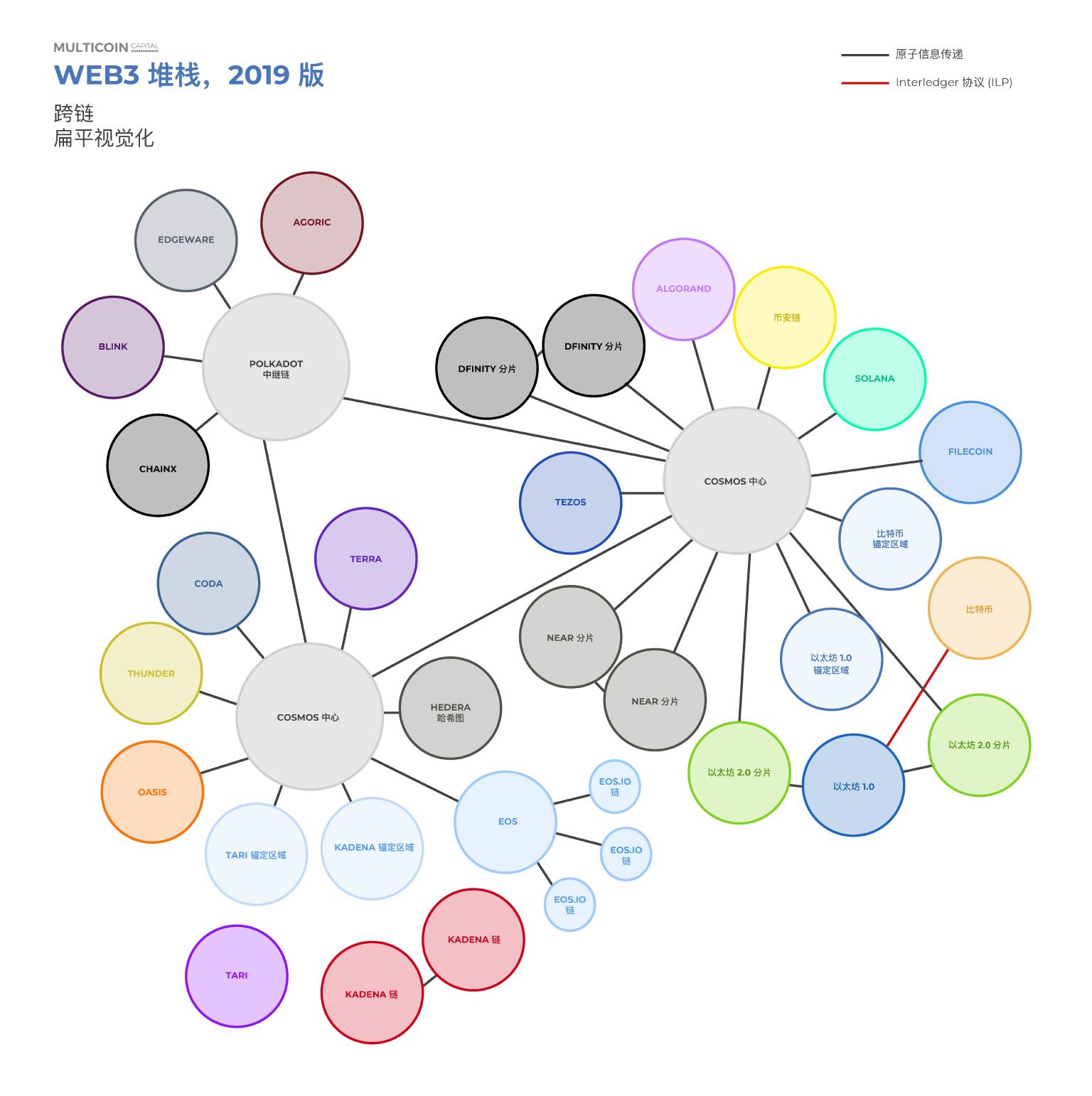
Although the Cosmos team expects multiple centers to appear over time, it is impossible to know in advance which chain will be connected to which center. I list 2 Cosmos centers because 1) I cannot list all non-Polkadot parachains around a center; 2) I expect many centers. Obviously, only one of these centers can be powered by ATOM. The second can be Iris or some other center. Binance Chain (built using the Cosmos SDK) itself can even become a hub. This is especially likely to happen if Binance DEX develops sufficient liquidity and can serve as a price predictor that minimizes the trust of all other chains.
Considering how early the interoperability mechanism is, this diagram doesn't provide much information-it mainly shows the future. The illustrations I have provided here are fairly clear; in reality, however, the situation may be more confusing. For example, with the exception of Bitcoin and Ethereum, Binance Chain has been able to promote economic activity more than any other chain. In addition, BNB has a higher market value, and its liquidity is much higher than ATOM, which means that Binance Chain may provide more consensus security than ATOM-based chains. In the end, Binance Chain is mainly a DEX. With sufficient liquidity, it can act as a price predictor with minimal trust. With these three structural advantages, the Cosmos SDK may become a de facto development standard, while Binance Chain and BNB can play their full value.
I also added an Interledger Protocol (ILP) bridge between Bitcoin and Ethereum 1.0 (bottom right) to show that not all forms of interoperability need to exist in the form of atomic messages passed through a central chain. Although ILP can theoretically bridge every chain in the diagram, I choose not to explain it this way because it makes the image difficult to read.
Web3 stack 2019: multi-chain, layered visualization
The final image is a combination of the first two images. The purpose of this visualization is to emphasize that the middleware network will operate across several layers 1:
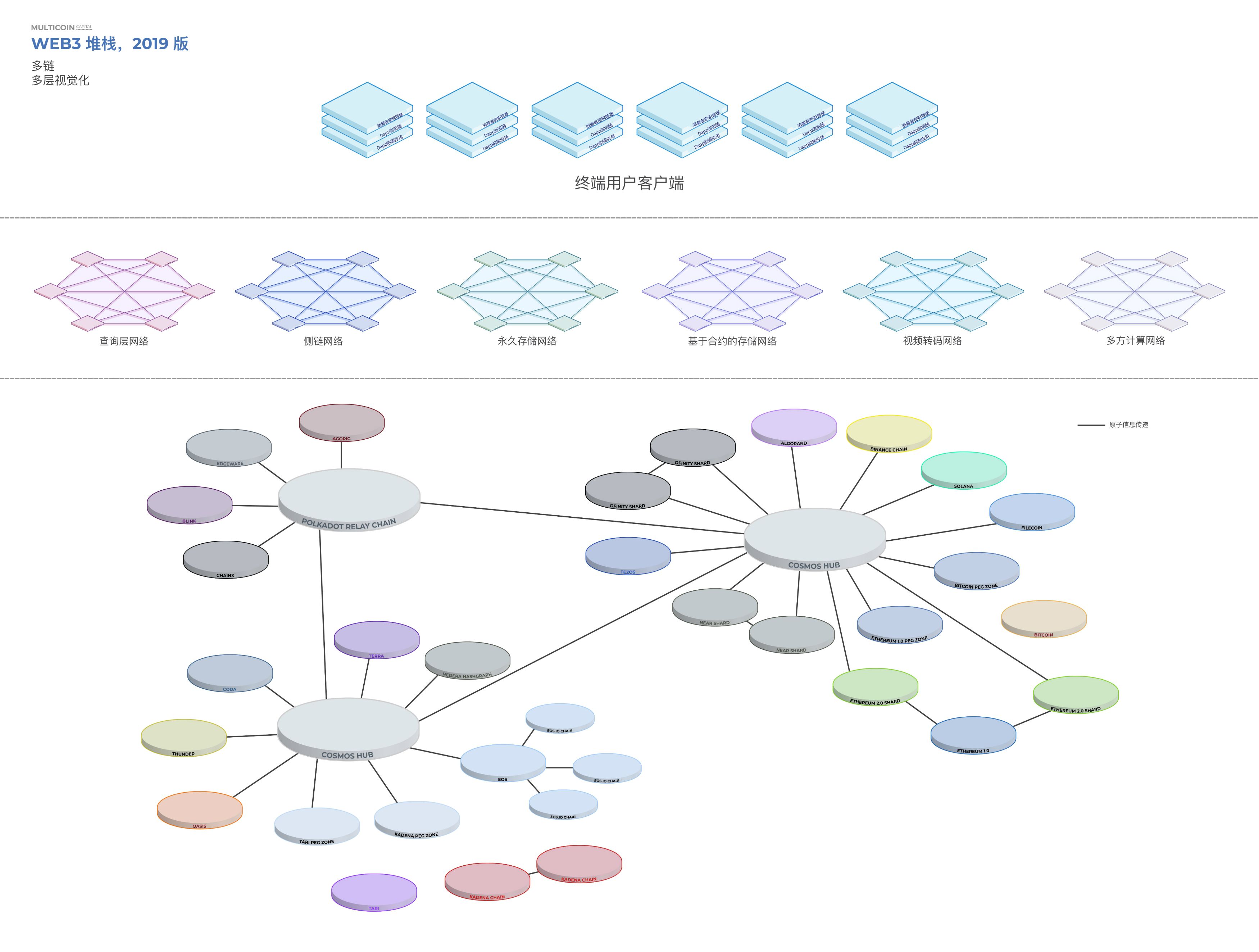
For readability, I 1) removed the ILP; 2) the blue arrows between the various end-user clients and the middleware stack were not preserved.
Some conclusions
The most incredible thing about the Web3 stack is that they can be grouped together without any centralized coordination. Development itself is decentralized. No main architect. This is in stark contrast to almost every other development stack project on the planet. At the Linux Foundation, a small number of people set the direction of Linux as a whole. The same is true on systems such as Google's Android and Apple's iOS. The few high-level personnel in these organizations determine the overall architecture of these large ecosystems.
Considering the lack of centralized coordination, it is truly incredible that all of this works. Of course, some projects still look awkward, but the developer and user experience is rapidly improving throughout the stack.
Often large changes begin slowly and then suddenly. Web3's current development model may follow a similar pattern. It's hard to predict when the situation will suddenly and quickly move forward, but at least the basic shapes and outlines of all major components are now available on the market, and in the developer community, there has been a general consensus on how to fully integrate them Understanding.
Thanks to Peng Zhong and Avani Miriyala for their help in graphic design.
Disclosure: Multicoin has developed, maintains, and implements well-designed written policies and procedures to identify and effectively manage conflicts of interest related to its investment activities. Multicoin Capital complies with the "No Trading Policy" for the assets listed in this report within 72 hours of its public release (the "No Trading Period"). During the period of no transaction, no senior management, director or employee may buy or sell any of the assets involved in the article. At the time of this report, positions held by Multicoin Capital included Kadena, Near, Solana, Dfinity, Oxio, Keep, dfuse, The Graph, Livepeer, Arweave, and Coda.
We will continue to update Blocking; if you have any questions or suggestions, please contact us!
Was this article helpful?
93 out of 132 found this helpful
Related articles
- Twitter CEO Jack has a dream: from electronic money to social networks
- Introduction to Blockchain | Filecoin launches testnet, is the age of IPFS coming?
- Vitalik Buterin: Persuading the Ethereum Foundation to sell $ 100 million ETH, and it is basically at the "highest point"
- Well-known institutions review 2019: the market recovers, but thanks to Bitcoin; Ethereum has not been killed
- Research Report | Blockchain Technology Empowers Bank Risk Management
- VeChain Foundation repurchase wallet stolen, $ 6.4 million missing
- Bank of America Merrill Lynch's best-performing asset in a decade, Bitcoin ranks first




